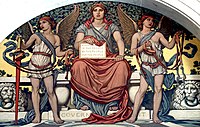
Photo from wikipedia
ABSTRACT This paper examines the level and volatility effect of monetary policy on housing prices in China utilizing a novel set of housing price indices constructed by (Fang, H., QuanlinGu,… Click to show full abstract
ABSTRACT This paper examines the level and volatility effect of monetary policy on housing prices in China utilizing a novel set of housing price indices constructed by (Fang, H., QuanlinGu, W. X., & Zhou, L.-A. (2015). Demystifying the Chinese housing boom. NBER Macroeconomics Annual 2015, Volume 30. University of Chicago Press.). We find that in the long-run, average housing prices react positively to inflation, money supply and bank lending growth, and negatively to the reserve requirement ratio and benchmark lending rate. Housing prices in Tier 1 cities respond more sensitively to monetary shocks relative to Tier 2 and 3 cities, possibly due to surging demand and limited supply under housing-purchase restrictions (HPR). We further study the volatility effect of monetary shocks using the GARCH model and find that the benchmark lending rate, reserve requirement ratio and money supply growth have strong negative impact on the volatility of housing price growth. Our benchmark results remain robust after incorporating the HPR policy variable in the estimation, with a significant negative effect of HPR on housing price growth in Tier 1 and Tier 2 cities. Lastly, we conclude with recommendations on future monetary policy design and implementation, with a specific focus on the heterogeneous characteristics of China’s housing market.
Journal Title: International Economic Journal
Year Published: 2019
Link to full text (if available)
Share on Social Media: Sign Up to like & get
recommendations!